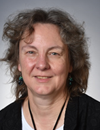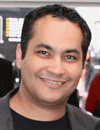08:00 | Registration |
|
Applications in Microfluidics |
| |
09:00 |  | Keynote Presentation Monitoring Cell and Tissue Culture in Microfabricated Systems
Elisabeth Verpoorte, Chair of Analytical Chemistry and Pharmaceutical Analysis, University of Groningen, Netherlands
Microfluidic technologies are enabling more sophisticated experimentation with cells and tissue. This presentation will consider monitoring of chemical parameters such as metabolites, dissolved oxygen and pH in small-volume (microliter or less) cell and tissue culture in microfluidic systems. |
|
09:30 | Microfluidic Devices for Long-Term 3D Cell Culture and Anticancer Drug Activity Evaluation
Zbigniew Brzozka, Professor, Warsaw University of Technology, Poland
The presentation will concern applications of microfluidic devices for cell culture and testing. Long-term two-dimensional and three-dimensional cell culture on-chip for anticancer drugs activity evaluation and photodynamic therapy testing will be discussed. |
10:00 | Tubeless Microfluidic Systems for Personalized Chemotherapy
Albert Folch, Professor of Bioengineering, University of Washington, United States of America
Presently, oncologists do not directly assess tumor chemosensitivity prior to choosing a chemotherapeutic regimen, resulting in inefficient therapies. Here we show a multiplexed microfluidic assay that utilizes intact tumor tissue and could be used to rapidly predict tumor chemosensitivity to a large panel of drugs prior to initiation of therapy. |
10:30 | Coffee Break & Networking in Exhibition Hall |
11:15 | Manipulating Magnetic Cells and Particles On-chip
Nicole Pamme, Professor in Analytical Chemistry, Stockholm University, Sweden
Microfluidics based approaches are presented for manoeuvring magnetically doped particles or magnetically labelled cells through fluidic interfaces by means of externally applied forces. |
11:45 | Paper-based Microfluidics: Something Old + Something New
Andrew Steckl, Gieringer Professor, Ohio Eminent Scholar, University Distinguished Research Professor, University of Cincinnati, United States of America
Paper-based microfluidic lab-on-chip devices using capillary flow provide an attractive alternative to conventional microfluidic devices in resource-poor and point-of-care environments. This presentation reviews this rapidly expanding field for low cost and simple to use bio/medical and other applications. |
12:15 |  Technology Spotlight: Technology Spotlight:
Case Study “Heart Check” and Manufacturing with Different Technologies for Medical Consumable Devices for Analytic and Diagnostics – Single Sourced
Harald Denz, MD & CEO,
This talk will be about a heart test instrument to be used at home by the patient, the results will be transmitted to the family doctor via GPRS. The cooperation with the customer was to support the development of the technical implementation of LOC plastic components. z-microsystems itself develops LOC-technologies which allow to manufacture components with increasingly finer and thinner structures.
|
12:30 | Lunch & Networking in Exhibition Hall |
13:30 | Poster Viewing Session |
14:15 | Integrated Inertial Pump for Micro-fluidic Application
Alexander Govyadinov, Senior Technologist, HP Incorporated, United States of America
The low-cost integrated inertial micro-pump is investigated. CFD model and variety of tested microfluidic geometries with pump’s array demonstrated feasibility of the inertial micro-pump technology. Potential applications of small form-factor integrated micro-fluidic pumps for Lab-on-Chip application is discussed. |
|
Applications of Lab-on-a-Chip |
| |
14:45 |  | Keynote Presentation Using Phononic Crystals to Shape Complex Fluid Flows
Jon Cooper, Professor, University of Glasgow, United Kingdom
We have developed phononic crystals that shape acoustic fields as "acoustic holograms", enabling the control of fluid flows. We demonstrate the technology in biomedical diagnostics to enable PCR, cell lysis and sample manipulation - with applications in rapid diagnostic tests. |
|
15:15 | Coffee Break & Networking in Exhibition Hall |
16:00 | Isotachophoresis in Microchannels: Beyond Separation of Analytes
Steffen Hardt, Professor, University of Technology Darmstadt, Germany
We show that microchannel isotachophoresis (ITP) displays a rich variety of interesting physical phenomena that may be utilized for a much broader scope of applications than only the separation of analytes. We demonstrate this by a number of examples, including ITP-based “digital microfluidics” and particle separation at ITP transition zones. |
16:30 | Biophotonic Lab on a Chip for Simultaneous Cell Retention and Monitoring
Xavier Muñoz, Senior Researcher, Microelectronics Institute of Barcelona (IMB-CNM), Spain
A biophotonic lab on a chip consisting on twin chambers and size-exclusion micofilters for real time cell retention and monitoring will be presented. As a proof of concept, they have been used for separate mixtures E-coli and S. cerevisiae and for pH monitoring of VSMC cultures. |
17:00 | High Throughput Fluorescence Detection of Phytoplankton using an Optofluidic Biosensor
Nastaran Hashemi, Assistant Professor, Iowa State University, United States of America
We have deigned an optofluidic biosensor for high throughput characterization of phytoplankton by their intrinsic fluorescence and light scatter. Phytoplankton with a wide range of sizes and shapes are successfully detected using this approach. |
17:45 | Round Table Discussions in Exhibition Hall |




